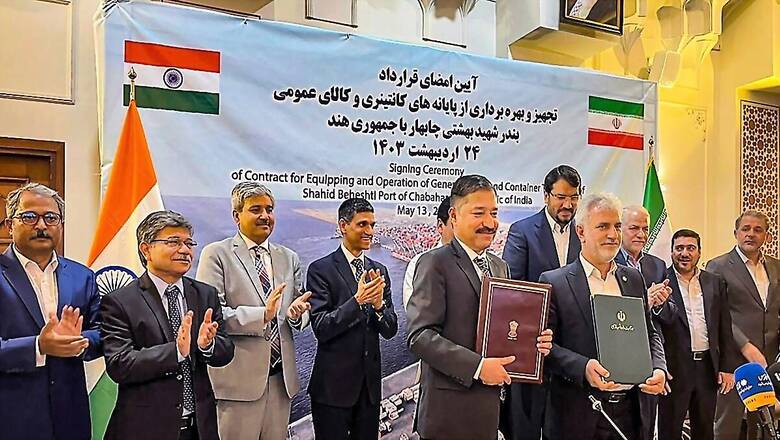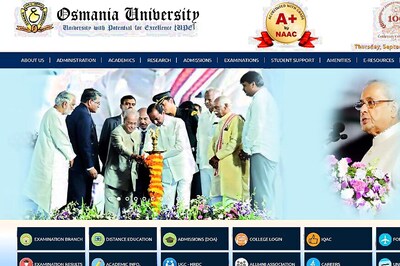
views
Geostrategy is increasingly becoming a process of increasing a nation’s options. Faced with Western economic sanctions, Iran and Russia have had to seek alternatives to survive and even thrive in the realm of unintended consequences. Sanctions as a geostrategic tool are facing their own limitations, and overuse by America and its NATO allies is spawning efforts to move away from the US dollar as the exclusive, or at least main currency of international commerce.
While Russia has been encountering sanctions from Western Europe and the US ever since the war with Ukraine, Iran has endured them for far longer. Over the years, both countries have proved ingenious by finding new trading partners and mechanisms of international trade.
China too, despite being the second largest economy in the world, and closely involved in trade with Western Europe and the US, is now facing sustained headwinds. Its economy has become sluggish. For a country that has been the established global manufacturer of myriad things for decades, this is a difficult pill to swallow. It is increasingly facing stiff US trade tariffs and outright bans.
With India, China has recently overtaken the US as the biggest exporter of its goods despite restrictions imposed. This is ironic because there is no let-up in the tense situation on its long Tibetan borders with India.
India is considered to be an important US partner if not a full-fledged ally in QUAD, and a lateral beneficiary of AUKUS, which puts it in the same frame with a number of G7 countries including Japan, Britain and Australia. It is equipping more and more of its ports to repair and refurbish US naval ships operating in its region. It is collaborating in its military manufacturing not only with Russia, France, and Israel but very significantly with the US. Countries like Germany that were not agreeable to letting India have access to its sophisticated military technology before have also changed their posture. India shares vital intelligence inputs with the US and other Western countries. And yet, it faced the finger-wagging threat of Western sanctions for importing Russian oil and gas, and possibly its neutrality. Though the pressure has eased as the Ukraine War drags on. In fact, it has refined some of the Russian crude and re-exported it to Western Europe.
The US, Israel and others in West Asia are aware of India’s cordial relationship with Iran. It is based on geostrategic as well as civilisational affinities. These other countries may be coming around to seeing its advantages. Remarks of the Indian foreign minister rather than its shipping minister, Sonowal, who signed the Chabahar contract hint at this.
India has a bilateral track of value with Iran. This partnership follows on as a much more comprehensive version of a 2016 agreement that was amped up only sectionally in 2018. But today, we can see a breakthrough.
In one fell swoop, it opens up a route through the countries of Central Asia by road and rail connectivity all the way up to Russia and on to Europe. It negates some of the potential of the Chinese-controlled Gwadar Port, the vulnerabilities of dealing with Pakistan’s Karachi Port, and the fear of a bottleneck at the Straits of Hormuz. Significantly, after Iran’s refusal to accept international arbitration, all arbitration on matters arising between Tehran and New Delhi with regard to the operations will now be settled by a three-person committee sitting in Muscat, Oman. Oman, strategically positioned, and trusted by both the West and India, has served as an effective intermediary between the two and Iran for many years.
It is, in the expected flowering of its potential, a second route in addition to the North-South Corridor from India, across the Arabian Sea, via UAE with connectivity to Saudi Arabia, through Israel, and on to Greece in Europe. That it is somewhat mired presently by the ongoing war in Gaza is hopefully a temporary thing. But Chabahar waking up will tend to leverage reasonableness on this parallel course too.
The problems with the Red Sea, the Gulf of Aden, Iran-backed Houthi attacks on the shipping of various nations, the Somali pirates, and the bottlenecks at the Suez Canal have to be addressed. The burgeoning insurance costs on this route, the reluctance of shippers to send vessels or cargos through this way, the hijackings and missile attacks, and conversely, spiralling shipping expenses and delays of routing via the Cape of Good Hope are all unsustainable burdens on international trade.
Iran has been selling most of its oil to China of late in bilateral currencies, at highly discounted rates. It is also selling some of it via Pakistan to try and bypass the Western sanctions, no doubt with tacit US approval. Russia’s Gazprom announced its first loss despite selling twice as much of the highly discounted gas to China as it was to Western Europe. Both countries badly need balancing options.
India’s sea and land route via Chabahar in southeastern Iran means easy access to Afghanistan. This has been proved already with wheat shipments to the latter. But energised, Chabahar has enormous potential. India has been pressured by the US to avoid or curtail the purchase of Iranian oil and gas in the past, but with low-cost options how long can this go on? India is forced to import 90 per cent of its ever-growing volume of petroleum. It must request the US to reconsider its position. The same had to be done when it had to import the S-400 missile shield system from Russia.
India is today in a unique position of having equity with multiple sides. It is a country useful to various others who may be looking for ways to climb down from obdurate positions. This too is recognised by Iran, Russia certainly, and tacitly, even by the US and China. The dragon must wish it was as palatable diplomatically, but their strident propaganda, wolf warrior ways, espionage, and trade dumping and bullying have queered the pitch.
Chabahar is the alternative to not only other ports and political groups, but the stumbling Chinese ambition of the Belt and Road initiative. The UAE and Saudi ports are also eager to be included. But Iran must be drawn from its position of hostility. If Iran does not block the Straits of Hormuz, nobody else will. Tensions can be managed.
The Indian Ports Global Limited (IPGL), its overseas ports authority, will invest at least $120 million into the Chabahar Port development now. A further $250 million odd in fresh financing is also being organised, said Mehrdad Bazrpash, Iranian Minister of Roads and Urban Development.
“It will clear the way for bigger investments to be made in the port,” said Indian External Affairs Minister (EAM) S Jaishankar. He urged the US not to take a narrow view. The development of Chabahar will benefit the entire region, and the EAM felt the US appreciates this potential, and has done so even in the past. And therein lies the most important part of this breakthrough that cannot prosper without US backing.
Circumstances became favourable for the development of Chabahar without constraints after Iran agreed to a control and monitoring regime on its uranium enrichment levels to prevent a weaponisation of its nuclear programme. Iran signed a joint comprehensive plan of action (JCPOA) with the EU, the five permanent members of the UNSC, plus Germany. That Iran and India should be taking such a bilateral strategic initiative has raised eyebrows in multiple quarters, but is missing the essential link. And this 10-year bilateral agreement may be further extended by mutual consent.
Chabahar is a deep-water port in Iran’s Sistan-Baluchistan province, closest to India, and located on the open sea. It is 550 nautical miles from Kandla in Gujarat, and 786 nautical miles from Mumbai. The potential sea, road, and rail corridor will cover India, Iran, Afghanistan, Armenia, Azerbaijan, Russia, Kazakhstan, Uzbekistan, and Europe – over some 7,200 km.
The writer is a Delhi-based political commentator. Views expressed in the above piece are personal and solely that of the author. They do not necessarily reflect News18’s views.




















Comments
0 comment